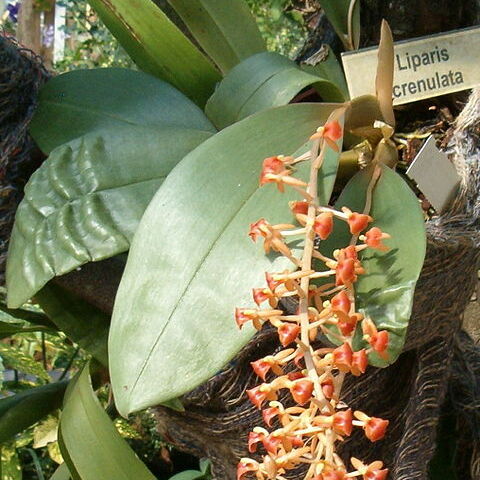Herbs, terrestrial, lithophytic, or epiphytic, rhizomatous, rarely mycotrophic and leaves reduced to scales. Stems pseudobulbous, sometimes appearing as a many-noded, fleshy stem, clustered or not, when young covered by sterile bracts. Leaves 1 to several, linear to ovate or elliptic, plicate or not, thinly textured to leathery, basal or cauline (terrestrial species), or arising from apex or subterminal nodes of pseudobulbs (epiphytic species), articulate or not at base. Inflorescences erect to pendulous, racemose, laxly or densely many flowered; floral bracts persistent, small. Flowers small or medium-sized, yellow, green, orange, or purple, often translucent, usually resupinate. Sepals spreading, dorsal sepal free, lateral sepals sometimes fused for part or all of their length. Petals free, often reflexed, often linear and unlike sepals; lip often reflexed, ovate, oblong, or flabellate, entire or lobed, usually with a basal callus, lacking a spur. Column incurved-arcuate, clavate, long, winged at apex and sometimes at base; anther cap attached by a slender filament, 2-locular; pollinia 4 in 2 pairs, waxy, ovoid, bilaterally flattened, each pair with a small viscidium; rostellum thinly textured, blunt. Capsule subglobose to ellipsoid, often ± with 3 obtuse ridges.
Small terrestrial or epiphytic herbs with pseudobulbous-stems. Leaves few (1-4), petiolate, the base of the petiole enclosing the pseudobulb; lamina mem-branaceous (in Panama), usually broad. Inflorescence a few-to several-flowered, terminal raceme. Flowers small. Sepals free, subequal, spreading. Petals sub-equal to the sepals or usually smaller and narrower. Lip erect or spreading, shortly adnate to the base of the column or free, sessile or usually shortly clawed, entire or usually emarginate, 1-to 2-tuberculate at the base, broader than the sepals. Column elongated (compared to that of Malaxis), arcuate, semi-terete, footless, usually parallel to the axis of the lip; anther terminal, operculate, in-cumbent, usually soon deciduous and versatile; pollinia 4, waxy, their long axis at right angles to the long axis of the column or nearly so.
Terrestrial and epiphytic herbs; stems usually ± swollen at the base to form pseudobulbs. Leaves basal or sometimes cauline, either broad, plicate, thin in texture and unjointed at the base, or else small, narrow, firm-textured and jointed at the base. Inflorescences few–many-flowered, terminal, mostly erect; rhachis terete or sometimes flattened or angular. Flowers rather small, usually yellowish green or purplish. Tepals spreading or reflexed, narrow, mostly with entire margins; petals often linear. Lip usually more fleshy than the tepals, simple or bilobed, with entire, dentate or crenulate margins, often bent in the middle, with 2 simple calli at the base. Column relatively elongated, usually curved over, terete or slightly winged, with or without a small foot; pollinia 4, pyriform, in 2 pairs.
Epiphytic, lithophytic or terrestrial herbs; stems usually swollen at the base to form pseudobulbs. Leaves 1 to several, broad, plicate, thin-textured and unjointed, or narrow, rigid and articulated at the base. Inflorescence terminal or subumbellate, usually erect, racemose, few-to many-flowered. Flowers usually yellow, yellow-green or purplish. Tepals spreading or reflexed, petals often linear. Lip simple, usually much larger than the sepals and petals, 2-lobed or 3-lobed, with entire, dentate or crenate margins, usually with 2 calli at the base. Column fairly long, arched, terete or somewhat winged, with or without a column-foot; pollinia 4, in 2 pairs.
Sep spreading, narrow, with incurved margins; lateral pet narrowly linear, usually turned forward under the lip, rolled and twisted, appearing thread-like; lip broad above a narrow base, declined; column longer than in Malaxis (in our spp. ca 3–4 mm), strongly curved, with narrow lateral wings above; pollinia 4; low orchids from a corm or pseudobulb, producing a few basal scale-lvs, 2 large, shining foliage lvs near the base, and a naked scape bearing a loose raceme. 250, ± cosmop.
Lip simple, usually much larger than the sepals and petals, 2-lobed or 3-lobed, with entire, dentate or crenate margins, usually with 2 calli at the base.
Leaves 1 to several, broad, plicate, thin-textured and unjointed, or narrow, rigid and articulated at the base.
Column fairly long, arched, terete or somewhat winged, with or without a column-foot; pollinia 4, in 2 pairs.
Epiphytic, lithophytic or terrestrial herb; stems usually ± swollen at the base to form pseudobulbs.
Inflorescence terminal or subumbellate, usually erect, racemose, few-to many-flowered.
Tepals spreading or reflexed, petals often linear.
Flowers usually yellow, yellow-green or purplish.

